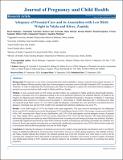Adequacy of Prenatal Care and its Association with Low Birth Weight in Ndola and Kitwe, Zambia
View/
Publication Date
2020-09-23Type
Article, Journalviews
downloads
Metadata
Show full item recordCitation
Mulenga D, Nyirenda T, Nyirenda HT, Mobegi D, Mubita B, et al. (2020) Adequacy of Prenatal Care and its Association with Low Birth Weight in Ndola and Kitwe, Zambia. J Preg Child Health 03: 108. DOI: 10.29011/JPCH-108.100008
Abstract/
Background: Prenatal care is one of the recommended interventions globally to improve maternal and neonatal outcomes. In most Sub-Saharan African countries, high rates of poor pregnancy outcomes coexist with high Antenatal (ANC) coverage rates. Therefore, in order to understand this inconsistency, this study was designed to explore the association between adequacy of prenatal care received and low birth weight in Ndola and Kitwe, Zambia. Method: A cross sectional study on 384 women and their babies was conducted in Ndola and Kitwe based health facilities. Adequacy of prenatal care was evaluated according to the seven parameters defined by the Zambian Ministry of Health in the Program for Maternal and Child Health: 1. Obstetric history 2. Intermitted Presumptive Treatment of Malaria 3. Nutritional supplements (folic acid/iron) 4. Tetanus toxoid vaccination 5. Deworming 6. Health Education and 7. Screening tests. Data was analysed using Stata version 13.1; low birth weight and adequacy of prenatal care were described. Associations between adequacy of prenatal care and low birth weight were calculated and statistical significance was set at 5%. Results: A low birth weight of 13.5% was found in the study population. The most received screening test was abdominal pelvic scan (84.9%) and the least was the blood group (19.5%) and Rhesus factor (18.0%). On average, women received 60.9% of the ANC screening tests. Based on our classification, only 2.9% of the participants received adequate content of prenatal care. Only slightly above a quarter (25.8%) of women started their ANC visit in the first trimester. The study demonstrated a statistically significant association (p value 0.001) between basic screening tests and timing of prenatal care initiation. Similarly, a statistically significant association (p value 0.001) between essential screening tests and timing of prenatal care initiation was observed. Receiving essential screening tests was statistically significantly associated (p value 0.025) with low birth weight and no association observed between prenatal care and low birth weight. Conclusion: Evaluating the adequacy of prenatal care received by mothers using appropriate classification tools is an efficient means of identifying deficiencies in the provision of preventive services to women during pregnancy. The findings in Kitwe and Ndola, Zambia indicate that mothers who initiated prenatal care in the first trimester were more likely to receive all the screening tests compared to those that started in subsequent trimesters. Therefore, interventions to improve quality of prenatal care should target timing of ANC initiation and factors related to the availability and accessibility to screening tests during pregnancy.
Further Details
This is an Open Access Journal Article Published Under Attribution-Share Alike CC BY-SA: Creative Commons Attribution-Share Alike 4.0 International License. With this license readers can share, distribute, download, even commercially, as long as the original source is properly cited.
Publisher
Gavin PublishersCollections
- General - GEN [367]

